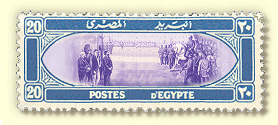On 8 August 1882, Captain George Surgeon, Lieutenant Thomas Vial and their 43 men sailed for Egypt on The British Prince, reaching Alexandria on 21 August, when an Army Post Office was opened. On the 27th a Field Post Office was opened at Tel el Mahuta and from that date a postal service to and from the front was operated. Once the brief campaign ended in mid-September the Army Post Office Corps men assembled in Cairo with the exception of the detachment at Alexandria. On 7 October, apart from the six men who remained to serve the troops remaining in Cairo, Sturgeon and his command left for home, receiving a tumultuous welcome in London on the 24th.
During the course of the campaign, six Army Post Offices had been opened, numbers 1 and 2 at Alexandria, 3 at Port Said, and 4 at Ismailia, with numbers 5 and 6
accompanying the march of the 1st and 2nd Divisions respectively. These offices used circular date stamps inscribed BRITISH ARMY POST OFFICE EGYPT.
The small differences have beenreported by Minett. The killer handstamps were hardly used, with only one recorded cover and a few pieces and loose stamps.
A similar killer was used at the jubilee of the penny postage exhibition.
In addition to making use of the facilities provided by the APOC the soldiers were also able to send via the Egyptian Post Office letters weighing up to 15 grams at a concessionary postage rate equivalent to one penny. Incoming letters addressed to non-commissioned officers and men could he sent at the penny rate, provided that they did not exceed half an ounce in weight. The British forces concessionary penny rate, 1d, rate for letters up to half an ounce for overseas service was implemented for servicemen of non officer rank. For commission ranks the rate was 2½d per half once and 1d for postcards. Letters without stamps were charged at 2½d instead of the double rate.
More than 7,000 troops were sent to Egypt from India and their postal needs were served by a separate service under the control of Mr J H Cornwall. He had with him a staff of fifteen who were equipped to man five FPOs, although only two of them, numbers 1 and 2, were in fact opened. They were supplied with handstamps very similar to those used by the APOC, the killers having the letter B in the centre and the datestamps reading FIELD FORCE P.O. EGYPT and bearing the number of the FPO at which they were used.
|

